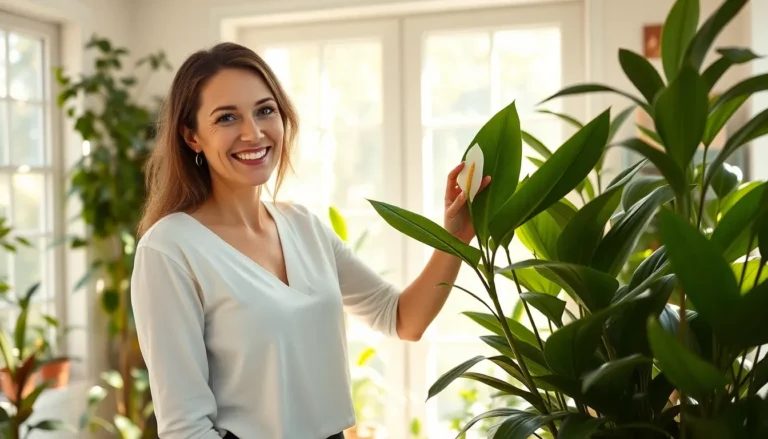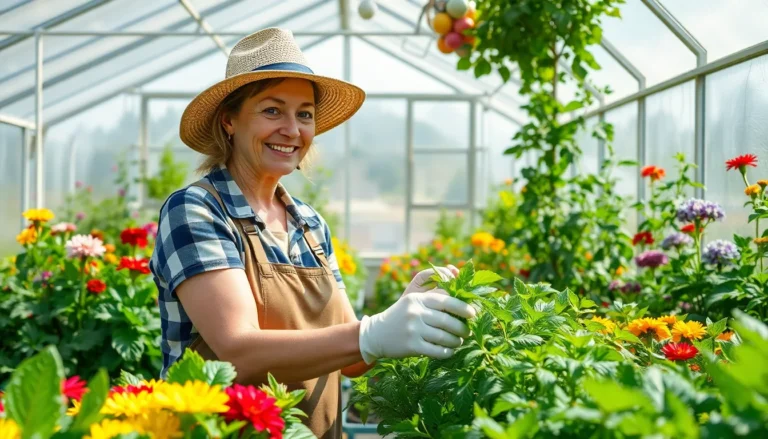Table of Contents
ToggleGnats in house plants are like that uninvited guest who shows up at a party and just won’t leave. They flit around, making themselves at home while you’re left wondering how to reclaim your green sanctuary. These tiny pests can turn your indoor oasis into a buzzing nightmare, but don’t panic. With a bit of knowledge and some clever strategies, it’s possible to send those pesky gnats packing.
Overview of Gnats in House Plants
Gnats often appear in house plants, creating a nuisance for indoor gardeners. These pests, primarily fungus gnats, thrive in damp soil rich with organic matter. Larvae feed on plant roots and decaying matter, leading to weakened plants. Signs of an infestation include adult gnats flying around plants and small larvae visible in the soil.
Many factors contribute to gnat infestations. Overwatering plants generates a favorable environment for gnats to breed. Soil that retains moisture, particularly potting mixes with high organic content, can attract these pests. Indoor humidity levels play a role, as increased humidity supports gnat reproduction.
Control methods vary depending on infestation severity. Reducing watering frequency dries out the soil, making it less hospitable. Using sticky traps also captures adult gnats, decreasing their population. Introducing beneficial nematodes into the soil helps combat larvae effectively.
Monitoring plants regularly helps catch infestations early. Observing plants for signs of stress aids in identifying potential gnat problems. If gnats persist, consider repotting plants with fresh, sterile soil. This practice removes eggs and larvae, providing a clean slate for plants.
Maintaining optimal care for house plants is crucial. Providing proper drainage and reducing organic debris in the soil prevents future infestations. Regularly inspecting plants for moisture levels minimizes gnat risk. Understanding gnat behavior contributes to effective management strategies. Keeping these principles in mind empowers gardeners to protect their indoor green spaces.
Types of Gnats Commonly Found

Identifying specific types of gnats is crucial for effective management. Two common culprits often found in house plants include fungus gnats and shore flies.
Fungus Gnats
Fungus gnats typically emerge from moist potting soils. Adult gnats resemble small flies and are often dark in color. Larvae feed on roots and decaying organic matter, which can weaken plants. Signs of an infestation include adult gnats flying around and larvae visible in the soil. Overwatering and poorly draining soil conditions encourage their populations. Management approaches involve letting the soil dry out, using sticky traps, and applying beneficial nematodes to control larvae.
Shore Flies
Shore flies share similarities with fungus gnats but differ in behavior and habitat. They often live in overly moist environments, particularly near water sources. Adults have a distinct appearance, featuring a more robust body and a broader wingspan. Though less harmful than fungus gnats, shore flies can still contribute to soil issues and indicate moisture problems. Preventing infestations involves removing standing water and improving drainage in pots. Regular soil monitoring helps keep these pests at bay while promoting healthy plant growth.
Causes of Gnat Infestations
Gnats thrive in indoor environments due to specific conditions that promote their breeding and survival. Understanding these causes can help in managing and preventing infestations.
Overwatering
Overwatering creates a perfect environment for gnats. Excess moisture in pots leads to damp soil that is ideal for fungus gnats to lay eggs. Roots weaken from constant saturation, making plants susceptible to damage. Additionally, the larvae feed on the roots, hindering plant growth. Ensuring that the top layer of soil dries out between waterings can mitigate this problem. Consider using a moisture meter to accurately assess soil dampness before watering. Adjusting the frequency of watering prevents the infestation from taking hold.
Poor Drainage
Poor drainage exacerbates gnat problems in house plants. When pots lack proper drainage holes, excess water accumulates at the bottom, creating a breeding ground for gnats. Roots may rot because they stay submerged in water, which attracts these pests. Improving drainage involves repotting plants into containers with sufficient drainage holes. Adding a layer of gravel at the bottom can also promote better water flow. Monitoring moisture levels and ensuring pots allow for drainage help maintain a healthy environment for house plants, reducing the risk of gnat infestations.
Identifying Gnats in House Plants
Detecting gnats in house plants involves recognizing specific signs and understanding their life cycle. This knowledge helps in early intervention and effective management.
Signs of Infestation
Adult gnats often fly around the plant, appearing as small dark flies. Larvae might be visible beneath the soil surface, characterized by their translucent bodies. Yellowing leaves can indicate root damage caused by gnat larvae feeding on roots. Additionally, stunted plant growth often results from stress due to gnat activity. If multiple signs are present, it becomes essential to take action quickly to minimize damage.
Life Cycle of Gnats
Gnats typically have four life stages: egg, larva, pupa, and adult. Female adult gnats lay eggs in moist soil, especially when conditions favor growth. After three to six days, eggs hatch into larvae that feed on decaying organic matter and plant roots. Within one to two weeks, larvae mature and pupate before emerging as adults. The entire life cycle can complete in as little as 20 days in ideal conditions. Understanding this cycle helps in choosing effective control methods.
Prevention and Control Methods
Addressing gnats in house plants involves effective prevention and control methods. Implementing these strategies can significantly reduce the likelihood of infestations.
Cultural Control
Cultural control focuses on modifying gardening practices. Allowing the top inch of potting soil to dry out reduces moisture, discouraging gnat reproduction. Using well-draining soil improves drainage and prevents water accumulation. Ensuring pots have drainage holes directs excess water away from the roots. Cleaning up organic debris from the surface discourages larvae habitat. Rotating pots and changing plant location may disrupt gnat life cycles, reducing visibility. Regular monitoring for signs of gnats helps catch infestations early. Adopting these practices promotes healthier plants while minimizing gnat attraction.
Chemical Control
Chemical control involves using targeted insecticides to mitigate gnat populations. Neem oil acts as an organic option, effectively disrupting gnat development. Insecticidal soaps can eliminate adults on contact, reducing their numbers quickly. Applying these treatments on a regular basis helps maintain control, especially in severe infestations. Always follow label instructions to ensure effectiveness while keeping plants safe. Systemic insecticides offer long-term solutions by absorbing into plant tissues. Employing this strategy requires careful planning to prevent unintended effects on beneficial insects. Chemical methods contribute to integrated pest management when used alongside cultural controls.
Dealing with gnats in house plants can be frustrating but it’s manageable with the right approach. By understanding their habits and life cycle gardeners can take proactive steps to prevent infestations. Regular monitoring and proper care are essential in maintaining healthy plants and keeping pests at bay.
Implementing effective control methods like allowing soil to dry out and using sticky traps can significantly reduce gnat populations. With diligence and a few practical strategies indoor gardeners can enjoy their green spaces without the nuisance of gnats. Keeping plants healthy and thriving is the ultimate goal, ensuring a peaceful and vibrant indoor garden.







